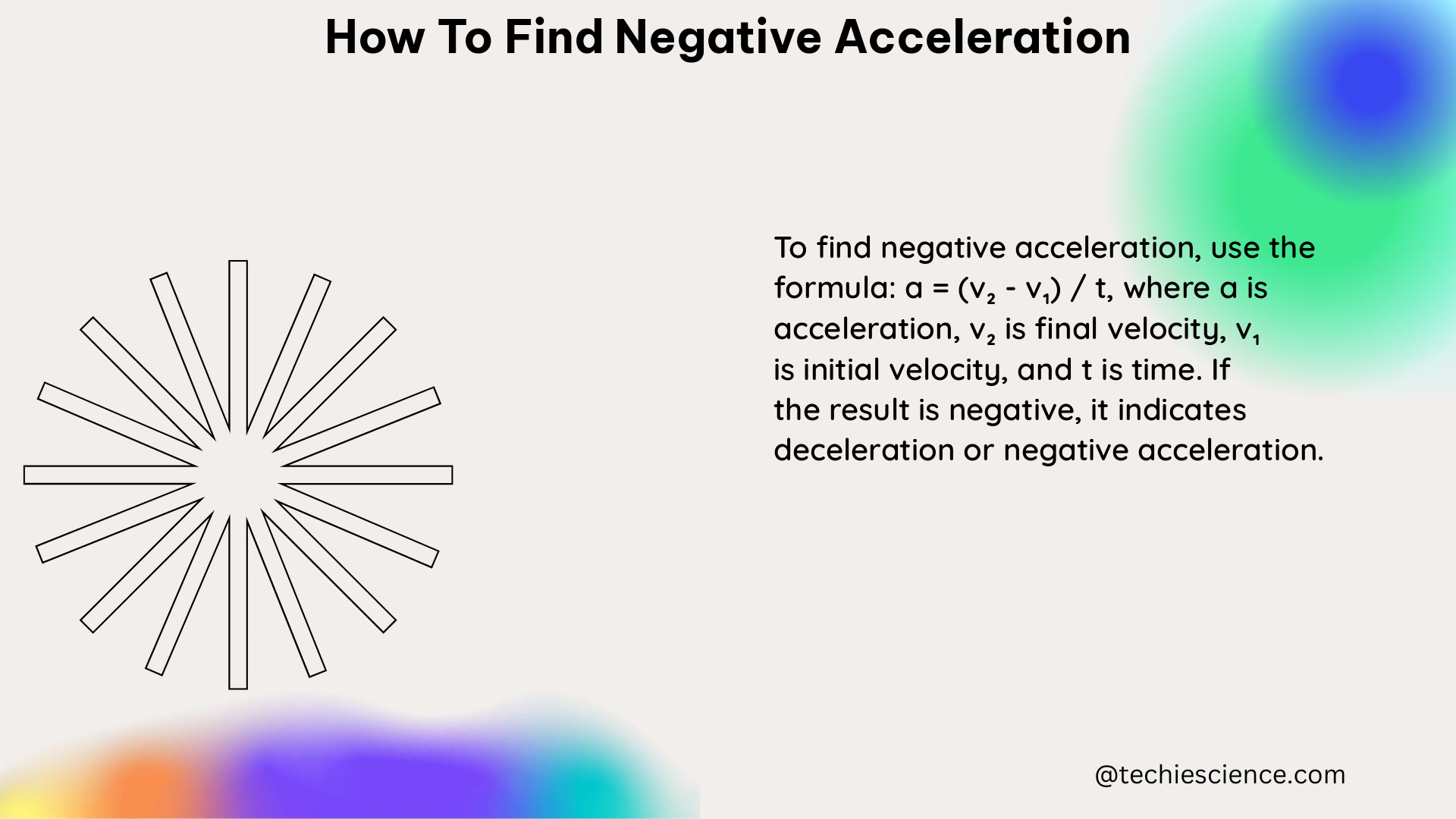Negative acceleration, also known as deceleration, is a crucial concept in physics that describes the decrease in an object’s velocity over time. Understanding how to calculate negative acceleration is essential for analyzing the motion of various objects, from cars braking to balls thrown upwards. In this comprehensive guide, we will delve into the details of finding negative acceleration, providing you with the necessary tools and techniques to master this fundamental topic.
Understanding Negative Acceleration
Negative acceleration occurs when an object’s velocity decreases over time. This can be caused by various factors, such as friction, air resistance, or intentional braking. The formula to calculate negative acceleration is:
a = (v - u) / t
where:
– a is the acceleration (negative in this case)
– v is the final velocity
– u is the initial velocity
– t is the time taken
The negative sign in the formula indicates that the acceleration is in the opposite direction of the motion.
Calculating Negative Acceleration: Examples

Let’s explore some examples to better understand how to find negative acceleration.
Example 1: Braking Car
Suppose a car is moving at a velocity of 20 m/s and comes to a stop in 5 seconds due to braking. We can calculate the negative acceleration as follows:
a = (0 - 20) / 5
a = -4 m/s^2
This means the car is experiencing a negative acceleration of 4 m/s^2, causing it to slow down and eventually stop.
Example 2: Upward Thrown Ball
Consider a ball thrown upwards with an initial velocity of 15 m/s. It takes 2 seconds for the ball to reach its maximum height, where its velocity becomes 0. We can calculate the negative acceleration due to gravity as follows:
a = (0 - 15) / 2
a = -7.5 m/s^2
This means the ball is experiencing a negative acceleration of 7.5 m/s^2 due to gravity, causing it to slow down and eventually stop at its maximum height before falling back down.
Factors Affecting Negative Acceleration
Negative acceleration can be influenced by various factors, including:
- Friction: Friction between an object and the surface it’s moving on can cause negative acceleration, as it opposes the object’s motion.
- Air Resistance: Air resistance, or drag, can also contribute to negative acceleration, especially for objects moving at high speeds.
- Braking: Intentional braking, such as applying the brakes on a car, is a common cause of negative acceleration.
- Gravity: For objects moving upwards, the force of gravity can cause negative acceleration, as it acts in the opposite direction of the motion.
Calculating Negative Acceleration: Theorems and Formulas
To find negative acceleration, you can use the following theorems and formulas:
- Kinematic Equations:
v = u + ats = ut + (1/2)at^2v^2 = u^2 + 2as
Where:
– v is the final velocity
– u is the initial velocity
– a is the acceleration (negative in this case)
– t is the time taken
– s is the displacement
- Newton’s Second Law of Motion:
F = ma-
Where
Fis the net force acting on the object,mis the mass of the object, andais the acceleration (negative in this case). -
Work-Energy Theorem:
W = ΔKE- Where
Wis the work done on the object, andΔKEis the change in kinetic energy.
By applying these theorems and formulas, you can calculate the negative acceleration of an object in various scenarios.
Numerical Problems and Solutions
To further solidify your understanding, let’s solve some numerical problems related to finding negative acceleration.
Problem 1
A car is traveling at a speed of 80 km/h and comes to a complete stop in 10 seconds. Calculate the negative acceleration of the car.
Solution:
Given:
– Initial velocity, u = 80 km/h = 22.22 m/s
– Final velocity, v = 0 m/s
– Time taken, t = 10 s
Using the formula:
a = (v - u) / t
a = (0 - 22.22) / 10
a = -2.222 m/s^2
Therefore, the negative acceleration of the car is 2.222 m/s^2.
Problem 2
A ball is thrown upwards with an initial velocity of 20 m/s. It takes 3 seconds for the ball to reach its maximum height, where its velocity becomes 0. Calculate the negative acceleration due to gravity.
Solution:
Given:
– Initial velocity, u = 20 m/s
– Final velocity, v = 0 m/s
– Time taken, t = 3 s
Using the formula:
a = (v - u) / t
a = (0 - 20) / 3
a = -6.67 m/s^2
Therefore, the negative acceleration due to gravity is 6.67 m/s^2.
Graphical Representation of Negative Acceleration
To better visualize the concept of negative acceleration, let’s consider a graph of velocity versus time.

In the graph, the velocity decreases over time, indicating negative acceleration. The slope of the line represents the acceleration, which is negative in this case.
Conclusion
Mastering the concept of negative acceleration is crucial for understanding the motion of objects in physics. By applying the formula a = (v - u) / t and understanding the factors that influence negative acceleration, you can effectively analyze and solve problems related to deceleration. Remember to practice with various examples and numerical problems to solidify your understanding of this important topic.
References
- Identifying Positive and Negative Acceleration
- Interpreting Negative Acceleration
- How to Calculate a Negative Acceleration
- The Physics Classroom’s Acceleration Concept Builder
- Khan Academy’s Acceleration and Motion Course

The lambdageeks.com Core SME Team is a group of experienced subject matter experts from diverse scientific and technical fields including Physics, Chemistry, Technology,Electronics & Electrical Engineering, Automotive, Mechanical Engineering. Our team collaborates to create high-quality, well-researched articles on a wide range of science and technology topics for the lambdageeks.com website.
All Our Senior SME are having more than 7 Years of experience in the respective fields . They are either Working Industry Professionals or assocaited With different Universities. Refer Our Authors Page to get to know About our Core SMEs.